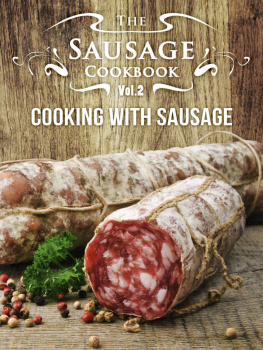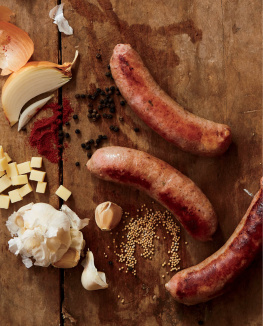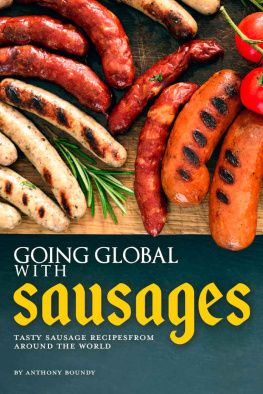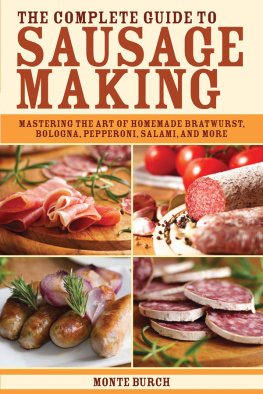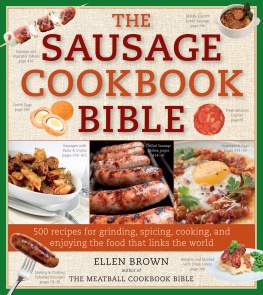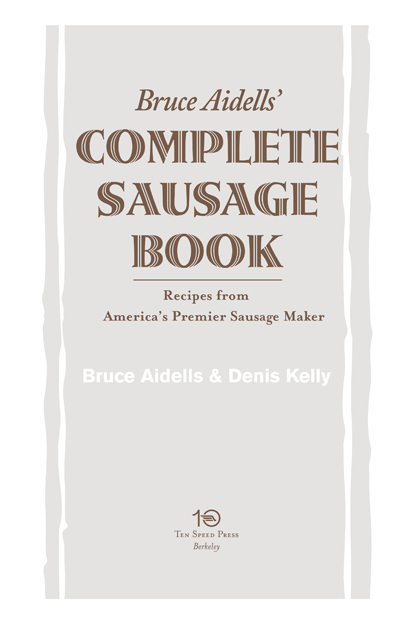Copyright 2000 by Bruce Aidells and Denis Kelly
All rights reserved. Published in the United States by Ten Speed Press, an imprint of the Crown Publishing Group, a division of Random House, Inc., New York.
www.crownpublishing.com
www.tenspeed.com
Ten Speed Press and the Ten Speed Press colophon are registered trademarks of Random House, Inc.
Library of Congress Cataloging-in-Publication Data
Aidells, Bruce
[Sausage book]
Bruce Aidellss complete sausage book : recipes & techniques from Americas premier sausage maker / by Bruce Aidells & Denis Kelly
p. cm.
I. Cookery (Sausages) 2. Sausages. I. Kelly, Denis, 1939
II. Title.
TX7490.5.S28 A3724 2000
641.6dc21 99-58199
eISBN: 978-0-307-80902-5
Photography: Beatriz da Costa
Food styling: Alison Attenborough
Prop styling: Eduoard Prulhiere
v3.1
Acknowledgments
N O BOOK IS WRITTEN WITHOUT A LOT OF VALUABLE HELP . W E WISH TO THANK our editors, Lorena Jones, Judith Jones, and Jackie Killeen; our photographer Beatriz da Costa, and our food stylist Alison Attenborough.
Martha Casselman, our literary agent, has been by our sides with valuable advice and encouragement for more than 15 years. Thank you.
And many thanks to our friends and colleagues who graciously contributed recipes: Bruces wife and chef-owner of Boulevard Restaurant, Nancy Oakes; Loni Kuhn; Robyn Cherin; Edy Young; Priscilla Yee; Bette Kroenig; Judy and Gary Wagner; Franco Dunn; and Steve Armbruster.
Contents
Introduction
S AUSAGEAS SOON AS YOU SAY THE WORD, THE MEMORIES BEGIN: S UNDAY morning, thick patties sizzling in the pan, filling the house with the fragrance of sage, pepper, and succulent pork. Or a late spring Saturday afternoon at the ball game, eating hot juicy franks with mustard and sauerkraut.
Just about everyone in America, from every background and region, has fond and satisfying memories of sausages. Wherever you grew up, from Bayonne to the Bayou Teche, its likely that sausage of one kind or another was found on your table or sold in the streets of your neighborhood. Whether its a hot dog or kielbasa, boudin or bratwurst, theres something about sausage that excites the taste buds and stays in the memory.
We grew up eating sausages of every type, taste, and description. Although were from different regions and ethnic backgrounds, we both pursued a passion for sausages across America, eating them at festivals and greasy spoons, fancy restaurants and waterfront dives, sampling Sheboygan brats, Cajun boudin, Italian cotechino, Oakland hot links, Chicago franks, whenever and wherever we had the chance. And one day, putting away a prodigious platter of Cajun cassoulet at a favorite restaurant, we decided to write a book about sausage in Americaits history and traditions, how to make it, how to use it, how it flavors so much of the best of our cooking.
By this time we had both been involved with food and wine professionally for many yearsDenis Kelly as a writer and teacher and Bruce Aidells as cookbook author, cooking teacher, and expert sausage maker. Bruce had become so enthusiastic about the savory subject, in fact, that he had become one of the countrys premier sausage makers, producing delicious, hand-crafted sausages at his Bay Areabased Aidells Sausage Company. How did Bruce get into the sausage-making business? He tells the story best: I first started making sausages when I was living in London, working as a cancer researcher, and trying to convince myself that the traditional British banger was made from anything other than sawdust, salt, and grease. Id been eating sausage all my lifefrom traditional, garlicky Jewish salami and frankfurters to more exotic types found in my neighborhood in Los Angeles, like chorizo and linguia. After a few months in cold, gray London subsisting on a diet of pub food and bangers, I was suffering from sausage deprivation and figured I could do better making them myself.
With the help of a cookbook and a small electric grinder I made up tasty batches of chorizo, American pork sausage with sage and pepper, Italian sausage with fennel, and Provenal sausage with garlic and herbs. It took me most of the night to stuff all Id made, but the next day when I fried them up and sat down to a hearty and delicious meal for the first time in months, I was hooked. From then on I never looked back, making (and eating) sausage at every opportunity.
When I returned to Berkeley, the Gourmet Ghetto near Chez Panisse was in full swing, and I ended up becoming a chef at Poulet, a popular restaurant and charcuterie. I just naturally kept on making sausage and learned what a wonderful flavoring ingredient it can be in soups, stews, pts, salads, and other hearty dishes. As the European peasants and regional American cooks had known for years, sausage is a great flavoring for almost any dish, and it doesnt take a lot to create exciting flavors and taste in a variety of dishes.
From then on the sausage phenomenon grew and grew, and finally I found myself making and selling a whole range of sausagesandouille and chaurice, chicken-apple sausage, Italian sausage, chorizo, and kielbasato restaurants and chefs. The response from them and from butchers, retailers, and home cooks all over the country testify to the interest in authentic handmade sausages in America today.
Ethnic and Regional Roots
S AUSAGE IS FOUND IN VIRTUALLY EVERY REGION AND ETHNIC TRADITION IN America. From the simple and satisfying pork and sage sausage of the Midwest, Cajun chaurice and New Bedford Portugese linguia to Italian sweet fennel sausage and Coney Island franks, sausage in one shape or another has long been an important part of American cooking. Sausages can serve as main dishes or as accompaniments and flavorings with vegetables, pasta, or beans. Whether you make them yourself or buy them ready-made, you can use sausages in dishes that range from traditional specialties like red beans and rice or cotechino with white beans to creative new combinations with vegetables, poultry, pasta, and seafood.
In this book, we take a close look at the regional and ethnic traditions that are at the heart of American cooking, and see how sausages are used to flavor and lend individual accents to these varied cuisines. Well show you exactly how to make the authentic sausages indigenous to each region: andouille and boudin from the Cajun country, hot and mild sausages from the Italian neighborhoods of northeastern cities, the ubiquitous American breakfast sausage, smoked and fresh kiebasas as Polish-Americans make it in Chicago, Sheboygans famous bratwurst, Chicago hot dogs, chorizo, linguia, Oakland hot links, and many more.
But this is more than just a book about sausage making. It is an overview of American cooking, using the sausage to link all the themes together. Well describe Americas regions and neighborhoods, their history, culinary traditions, and festivals. And well give you plenty of recipes that use sausage to flavor everything from a traditional gumbo to fashionable composed salads.
A Juicy History
A COOK TURNS A SAUSAGE, BIG WITH BLOOD AND FAT, OVER A SCORCHING blaze, without a pause to broil it quick. A modern Californian grilling a tasty sausage over mesquite charcoal? Well, it was probably a blood sausage much like our boudin noir, and it might even have been grilled over charcoal, but the time and place was Greece in about 700 B.C . This quote from Homers



